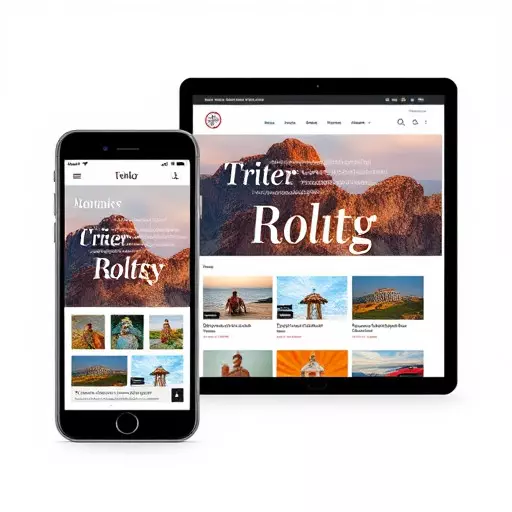In the competitive e-commerce landscape of New Jersey, mobile-first responsive design is essential for success. By adopting this approach, businesses create websites optimized for smaller screens, ensuring a top-notch user experience across all devices using fluid grid layouts and flexible images. This strategy boosts SEO rankings, user satisfaction, and retention in a mobile-driven market, ultimately driving sales and competitiveness.
In today’s digital era, ensuring a seamless user experience across various devices is paramount for e-commerce success. New Jersey, with its thriving online market, stands to gain significantly from adopting mobile-first responsive design principles. This article explores the transformative power of adaptive web design, focusing on fluid grid layouts and optimized flexible images and media. We delve into best practices for implementation, highlighting case studies that showcase how responsive design has revitalized top New Jersey e-commerce sites.
- Understanding Mobile-First Responsive Design: A New Jersey Perspective
- Benefits of Adaptive Web Design for E-commerce Success
- Mastering Fluid Grid Layouts: The Cornerstone of Responsive E-commerce
- Optimizing Flexible Images and Media for Enhanced User Experience
- Best Practices for Implementing Responsive Design in E-commerce Platforms
- Case Studies: How Responsive Design Transformed Top New Jersey E-commerce Sites
Understanding Mobile-First Responsive Design: A New Jersey Perspective

In the dynamic landscape of e-commerce, where consumer behavior is increasingly shaped by mobile interactions, adopting a mobile-first responsive design approach is no longer an option but a necessity. New Jersey, as a hub for businesses and technology, has recognized this shift and embraced adaptive web design strategies to stay competitive. At its core, mobile-first responsive design involves creating websites that are designed for mobile devices first, ensuring optimal viewing and user experience across all platforms. This method contrasts with the traditional “desktop-first” approach, where websites are built for larger screens and then adapted for smaller ones.
By prioritizing mobile users, New Jersey businesses can leverage fluid grid layouts to create adaptive web designs that respond gracefully to different screen sizes and resolutions. Furthermore, implementing flexible images and media ensures that visual content adjusts seamlessly, preventing clunky scaling or cropping issues. This attention to detail enhances not just the user experience but also search engine optimization (SEO), as Google prioritizes mobile-friendly sites in its rankings. Thus, for New Jersey’s e-commerce sector, embracing mobile-first responsive design is a strategic move to capture and retain customers in an increasingly mobile world.
Benefits of Adaptive Web Design for E-commerce Success

In today’s digital era, where a significant portion of online shopping occurs via mobile devices, Adaptive Web Design is no longer an option but a necessity for e-commerce success in New Jersey. Mobile-first responsive design ensures that websites seamlessly adjust to different screen sizes and resolutions, providing an optimal user experience regardless of the device used. This approach, coupled with fluid grid layouts, allows for dynamic content arrangements, ensuring every element remains visible and easily accessible on smartphones, tablets, or desktops.
Implementing Adaptive Web Design also enables businesses to optimize flexible images and media, loading faster and reducing bounce rates. By prioritizing mobile users and leveraging modern design techniques like fluid grids and responsive assets, e-commerce sites can enhance user engagement, improve conversion rates, and stay competitive in the New Jersey market.
Mastering Fluid Grid Layouts: The Cornerstone of Responsive E-commerce

In the realm of e-commerce, where customers increasingly shop on their smartphones and tablets, mobile-first responsive design in New Jersey is no longer an option but a necessity. Adaptive web design plays a pivotal role in ensuring that online stores not only look good but also function seamlessly across various devices. At the heart of this adaptability lie fluid grid layouts, which allow for dynamic and flexible arrangements of content as screen sizes change.
By adopting fluid grid layouts, e-commerce sites can achieve graceful degradation and enhancement regardless of whether a user is on a smartphone, tablet, or desktop computer. This means that flexible images and media adjust proportionally, ensuring that the user experience remains consistent while optimizing for speed and performance. Such responsive design not only caters to diverse users but also enhances search engine optimization (SEO), making your online store more visible and attractive to potential customers in a highly competitive market.
Optimizing Flexible Images and Media for Enhanced User Experience

In the realm of e-commerce, where the majority of users now shop from their mobile devices in New Jersey, optimizing flexible images and media is a cornerstone of a successful mobile-first responsive design strategy. Adaptive web design techniques, such as fluid grid layouts, allow for seamless viewing experiences across various screen sizes, ensuring that every customer interacts with visually appealing and easy-to-navigate product displays. By employing these strategies, retailers can create an engaging environment where flexible images adapt gracefully to different screens, enhancing the user experience regardless of whether they’re on a smartphone, tablet, or desktop computer.
This adaptability extends to media elements like videos and interactive graphics, which are crucial for showcasing products effectively. Fluid grid layouts enable these media components to resize proportionally, preventing cramped or distorted visuals that can frustrate users. Instead, customers enjoy a clean, uncluttered interface that highlights product features without sacrificing performance, even on slower internet connections. Ultimately, this focus on flexible images and media contributes significantly to higher user engagement and conversion rates in the competitive New Jersey e-commerce landscape.
Best Practices for Implementing Responsive Design in E-commerce Platforms

Implementing responsive design in e-commerce platforms is essential for providing an optimal shopping experience across all devices, especially in competitive markets like New Jersey. The foundation of a successful strategy lies in adopting a mobile-first responsive design approach, ensuring your site prioritizes mobile viewing before scaling up for larger screens. This means designing with the understanding that most users will access your e-commerce platform via smartphones and tablets, accommodating their smaller screens and touch interactions first.
Utilizing adaptive web design techniques, such as fluid grid layouts, is key to achieving this. These layouts adjust dynamically based on the screen size, ensuring content remains legible and easily navigable. Additionally, implementing flexible images and media allows for optimal display regardless of device, enhancing user experience without sacrificing performance. This adaptability not only caters to the diverse preferences of New Jersey consumers but also aligns with current industry standards, fostering a seamless and engaging online shopping journey.
Case Studies: How Responsive Design Transformed Top New Jersey E-commerce Sites

In recent years, mobile-first responsive design has emerged as a game-changer in the e-commerce landscape, particularly for businesses in New Jersey aiming to thrive online. Top New Jersey e-commerce sites have been quick to adopt this strategy, and the results speak for themselves. By prioritizing mobile users and implementing adaptive web design, these sites have not only improved user experience but also witnessed significant growth in sales and customer engagement.
The power of fluid grid layouts and flexible images and media lies in their ability to adapt seamlessly across various devices, from smartphones to desktops. This approach ensures that every visitor enjoys a consistent, high-quality experience. Case studies reveal that New Jersey e-commerce giants who embraced responsive design early on have seen increased conversion rates, reduced bounce rates, and improved overall website performance. Such transformations highlight the necessity of mobile-first responsive design as a key strategy for online success in today’s mobile-centric world.


